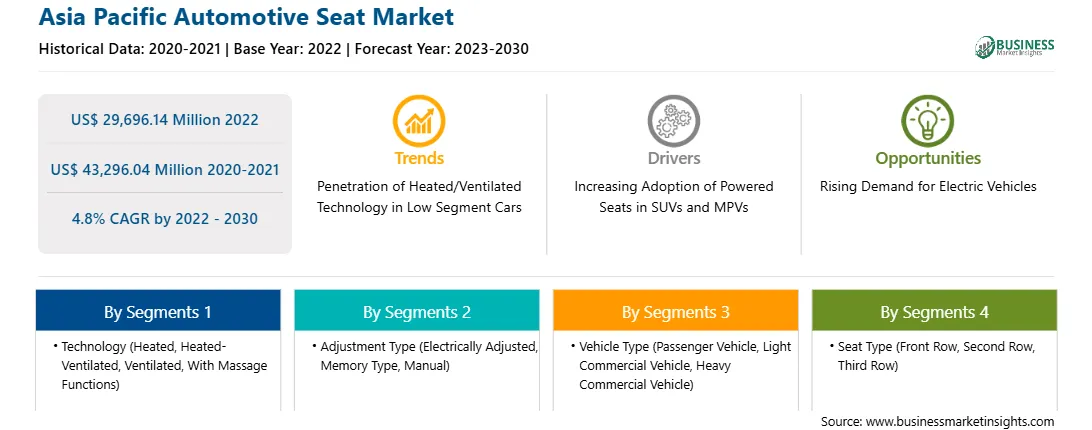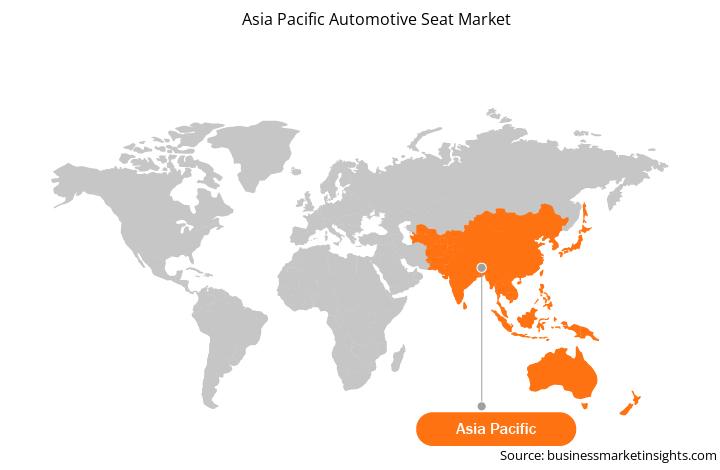Premium vehicles have gained traction due to technology advancements that enhance driving experience and provide added safety features. Further, increasing disposable income has fueled the sales of premium vehicles. According to Trading Economics, the disposable personal income in India was US$ 2,415,846 million in 2020, which increased to US$ 2,886,265 million in 2021. It is expected to reach US$ 2,987,285 million in 2023 and US$ 3,221,733 million by 2025. Advanced automotive seats are among the latest technologies incorporated in premium vehicles. Heat/ventilated seats, heating coils, and electrically adjustable seats are a few advanced seat features that add extra comfort and luxury to the consumer. Comfortable seats have become the consumer's choice while traveling long distances. Relaxed, cozy, and restful seats help passengers avoid fatigue and motion sickness while traveling. Market players are constantly unveiling additional features in the automotive seats. In September 2022, Japan-based NHK Spring Co., Ltd. developed seats for self-driving cars to reduce passenger motion sickness. These seats are designed in such shape and size that helps passengers sit in a comfortable and relaxing position for long journeys. Thus, the aforementioned factors are increasing the demand for premium vehicles, thereby driving the Asia Pacific automotive seat market growth.
Based on country, the Asia Pacific automotive seat market is segmented into Australia, China, India, Japan, South Korea, and the Rest of Asia Pacific. The automotive industry across Asia Pacific has been experiencing significant growth over the years. According to the International Organization of Motor Vehicle Manufacturers, countries such as India, China, Indonesia, South Korea, and Thailand experienced a significant rise in vehicle production volume in 2022. Additionally, regional and global automotive manufacturers are investing in establishing new vehicle production plants across the region. For instance, in March 2022, Triton Electric Vehicle LLC announced the launch of its new production plant in Gujarat, India. In addition, in June 2022, BMW announced the opening of its new electric vehicle production plant in China with an investment of US$ 2.2 billion. The launch of new vehicle production plants is expected to increase the demand for automotive seats, contributing to the Asia Pacific automotive seat market growth in the region. Government initiatives such as subsidies and tax rebates to encourage the adoption of electric vehicles are expected to boost the sales of electric vehicles. Governments are investing in charging infrastructures through direct investments. For instance, in 2021, the Government of India allocated incentives of US$ 486 million for adopting 7,090 e-buses amounting to a subsidy of US$ 69,000 per bus. Also, in April 2021, the Indonesian government set a goal for adopting the EVs and to have 20% production of all domestic cars manufactured, which will be approximately 400,000 EVs, by 2025. Such growth prospects in the electric vehicle industry fuel the Asia Pacific automotive seat market growth.
The Asia Pacific automotive seat market is segmented into technology, adjustment type, vehicle type, seat type, and country.
Based on technology, the Asia Pacific automotive seat market is segmented into heated, heated-ventilated, ventilated, massage functions, and others. In 2022, the heated segment registered the largest share in the Asia Pacific automotive seat market.
Based on adjustment type, the Asia Pacific automotive seat market is segmented into electrically adjusted, memory type, and manual. In 2022, the electrically adjusted segment registered the largest share in the Asia Pacific automotive seat market. The electrically adjusted segment is further segmented into 4 ways, 6 ways, 8 ways, 12 ways, and others. The memory type segment is further segmented into with memory function and without memory function.
Based on vehicle type, the Asia Pacific automotive seat market is segmented into passenger vehicle, light commercial vehicle, and heavy commercial vehicle. In 2022, the passenger vehicle segment registered the largest share in the Asia Pacific automotive seat market.
Based on seat type, the Asia Pacific automotive seat market is segmented into front row, second row, and third row. In 2022, the front row segment registered the largest share in the Asia Pacific automotive seat market. The front row segment is further segmented into regular, bucket, and sports. The second-row segment is further segmented into bench and captain. The third-row segment is further segmented into bench and captain.
Based on country, the Asia Pacific automotive seat market is segmented into China, Japan, India, South Korea, and the Rest of Asia Pacific. In 2022, China segment registered the largest share in the Asia Pacific automotive seat market.
Adient Plc, Bharat Seats Ltd, Forvia, Summit Auto Body Industry Co Ltd, Lear Corp, Magna International Inc, NHK Spring Co Ltd, RECARO Holding GmbH, Tachi-S Engineering USA Inc, Toyota Boshoku Corp, and TS Tech Co Ltd are some of the leading companies operating in the Asia Pacific automotive seat market.
Strategic insights for the Asia Pacific Automotive Seat provides data-driven analysis of the industry landscape, including current trends, key players, and regional nuances. These insights offer actionable recommendations, enabling readers to differentiate themselves from competitors by identifying untapped segments or developing unique value propositions. Leveraging data analytics, these insights help industry players anticipate the market shifts, whether investors, manufacturers, or other stakeholders. A future-oriented perspective is essential, helping stakeholders anticipate market shifts and position themselves for long-term success in this dynamic region. Ultimately, effective strategic insights empower readers to make informed decisions that drive profitability and achieve their business objectives within the market.

| Report Attribute | Details |
|---|---|
| Market size in 2022 | US$ 29,696.14 Million |
| Market Size by 2030 | US$ 43,296.04 Million |
| CAGR (2022 - 2030) | 4.8% |
| Historical Data | 2020-2021 |
| Forecast period | 2023-2030 |
| Segments Covered |
By Technology
|
| Regions and Countries Covered | Asia-Pacific
|
| Market leaders and key company profiles |
|
The geographic scope of the Asia Pacific Automotive Seat refers to the specific areas in which a business operates and competes. Understanding local distinctions, such as diverse consumer preferences (e.g., demand for specific plug types or battery backup durations), varying economic conditions, and regulatory environments, is crucial for tailoring strategies to specific markets. Businesses can expand their reach by identifying underserved areas or adapting their offerings to meet local demands. A clear market focus allows for more effective resource allocation, targeted marketing campaigns, and better positioning against local competitors, ultimately driving growth in those targeted areas.

The Asia Pacific Automotive Seat Market is valued at US$ 29,696.14 Million in 2022, it is projected to reach US$ 43,296.04 Million by 2030.
As per our report Asia Pacific Automotive Seat Market, the market size is valued at US$ 29,696.14 Million in 2022, projecting it to reach US$ 43,296.04 Million by 2030. This translates to a CAGR of approximately 4.8% during the forecast period.
The Asia Pacific Automotive Seat Market report typically cover these key segments-
The historic period, base year, and forecast period can vary slightly depending on the specific market research report. However, for the Asia Pacific Automotive Seat Market report:
The Asia Pacific Automotive Seat Market is populated by several key players, each contributing to its growth and innovation. Some of the major players include:
The Asia Pacific Automotive Seat Market report is valuable for diverse stakeholders, including:
Essentially, anyone involved in or considering involvement in the Asia Pacific Automotive Seat Market value chain can benefit from the information contained in a comprehensive market report.